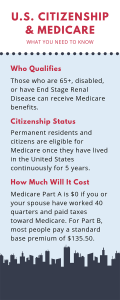What you should know about Medicare
This is a guest post by Danielle Kunkle.
If you are 65 or over and planning a move to the USA or have recently arrived in the USA, one of the first things you’ll need to square away is your healthcare. Here in America, Medicare is the federal insurance program for people aged 65 and older or younger people with certain disabilities.
This program covers about 80% of the healthcare expenses for recipients, who are called beneficiaries. These beneficiaries will pay the other 20% as well as deductibles and copays, or they can purchase supplemental insurance coverage to help pay for these items.
Let’s look at how you qualify and what the program costs.
 Applying for Medicare
Applying for Medicare
You are eligible to enroll in Medicare once you have become a permanent resident and have also lived in the United States continuously for five years. Remember, Medicare is for people aged 65 and older, so if you need health insurance before you turn 65, you can check into plans under the Affordable Care Act that are offered through the Healthcare Exchange in your state.
You will submit your Medicare application via the Social Security office. Make an appointment at your local office to save waiting time on the day of your appointment.
Medicare Costs and Coverage
Original Medicare is made up of two parts. Part A provides for inpatient hospital expenses, skilled nursing, and hospice. Part B provides for outpatient services such as doctor visits, lab testing, diagnostic imaging, emergency care, medical supplies, medical equipment, outpatient surgeries, chemotherapy, and dialysis.
Part A costs nothing if you have worked at least 40 quarters (10 years) or you are married for at least a year to someone who has worked these quarters and is at least age 62. If you do not qualify for premium-free Part A, then you pay for Part A. In 2019, it costs $437/month. Individuals who have at least 30 – 39 quarters can pay a pro-rated amount of $240.
Part B has monthly premiums for everyone. The standard base rate is $135.50 in 2019, and this is the amount that most people pay. However, about 5% of beneficiaries pay more based on their higher incomes. Premiums are billed quarterly to you unless you also have Social Security income benefits; then they would be deducted from those benefits monthly.
Medicare Part D is voluntary prescription drug coverage. You enroll in this coverage by applying for a Part D plan with an insurance company that offers a plan in your residential area. Premiums vary, but plans start around $15 – $20/month in most states. People with higher incomes also pay more for Part D. Premiums are paid directly to the insurance company that is providing your Part D plan.
Covering the Gaps
As we mentioned earlier, Medicare does not pay for 100% of your expenses, so most people enroll in some type of supplemental coverage to pay for the rest.
There are two main types of coverage you can choose for this: Medicare Supplements vs Medicare Advantage plans. You must first sign up for both Medicare Parts A and B before you are eligible to purchase a Medicare Supplement.
Medicare Supplements pay after Medicare pays its share of your expenses. These supplement plans are sometimes referred to as Medigap plans. People with Medicare supplement plans can see any Medicare provider in the nation. There are no referrals necessary, so this coverage appeals greatly to people who plan to travel throughout the United States.
There are ten different Medicare supplement plans to choose from. The most comprehensive plans are Plan F and Plan G, where you would owe little nothing because the plan covers nearly all Part A and B related costs. There are also plans with lesser benefits that would have lower premiums.
Plans do not include outpatient drug coverage, but policyholders can purchase standalone Part D coverage to go alongside it that will help with the costs of their medications.
Medicare Advantage plans work very differently. These are private plans in which you can enroll to get your benefits through a local network of providers. Some plans may be an HMO-style network where you’ll need to choose a primary care provider and see that doctor first for a referral before you can visit a specialist. Others might be PPO-style plans where you can see doctors outside the network at a higher cost.
Many Medicare Advantage plans include the Part D drug plans rolled right into the plan. They may also include some ancillary benefits like dental, vision and hearing coverage or gym memberships. Premiums are typically less than Medigap plans, but you’ll pay copays and coinsurance for the services as you go along.
Danielle K Roberts is the co-founder of Boomer Benefits where she and her team help baby boomers navigate their Medicare insurance options. She is a member of the Forbes Finance Council and writes frequently about Medicare, retirement and personal finance.






Leave a Reply